This article was written exclusively for Investing.com
- 2008-2012: wild and bullish period for agricultural commodities
- A model for 2020 and coming years for three reasons
- Grain and oilseeds could be pressured lower in coming months
- Archer Daniels Midland: leading agricultural company worldwide
- Bunge: another leader with exposure to Brazil
The 2021 crop year in the US and the northern hemisphere is winding down as we're now in the harvest season. Over the past months, nearby soybean futures rose to the highest price since July 2012. The 2021 peak in nearby corn futures reached the highest price since October 2012, and CBOT soft red winter wheat futures moved to highs not seen since January 2013. Oat futures reached a new record high in 2021.
After eight bearish years for the top grain and oilseed markets, prices exploded higher during an almost perfect bullish storm created by many factors rising. Inflationary pressures, pandemic-related labor and supply chain issues, higher energy prices, changing US policy increasing the demand for biofuel, and the ever-growing demand from an expanding world population have pushed prices higher.
Over the coming months—in the aftermath of the harvest—the focus on grain, oilseed, and other agricultural markets will shift below the equator to the critical growing regions in the southern hemisphere. Agricultural commodity prices have corrected from the 2021 highs, which could be an opportunity to buy the companies that feed the world.
The most powerful ag commodity companies are the ABCD group, including Archer Daniels Midland (NYSE:ADM), Bunge (NYSE:BG), Cargill, and Netherlands-based Louis Dreyfus. ADM and BG are publicly traded companies, while Cargill and Dreyfus are privately held.
I am a buyer of ADM and BG on any price weakness over the coming months. Higher agricultural commodity prices and increasing global energy demand will continue to turbocharge the profits of ADM and BG in the months and years ahead.
2008-2012: wild and bullish period for agricultural commodities
The 2008 global financial crisis introduced a new set of tools that governments could use to stabilize the financial system, following an event that caused economic turmoil. In 2008 the US housing market melted down after the mortgage-backed securities market tanked, exposing financial institutions and real estate-related businesses to devastating losses. A sovereign debt crisis in Europe added to the woes causing overall systemic risk.
Central banks slashed short-term interest rates to historic lows and used quantitative easing to push interests rates lower further out along the yield curve. Inhibiting saving and encouraging borrowing and spending stimulated economic conditions during the challenging period.
However, one of the side effects was growing debt levels and inflationary pressures. After all, running the printing presses to create more currency that provided liquidity to the system had an inflationary backlash. Commodity prices are highly sensitive to inflationary pressures. From 2008 through 2012, most raw material prices rose to multi-year or all-time highs.
Agricultural products were no exception. While the outbreak of the 2008 crisis initially pushed prices lower, the treatment lifted them over the next three to four years.
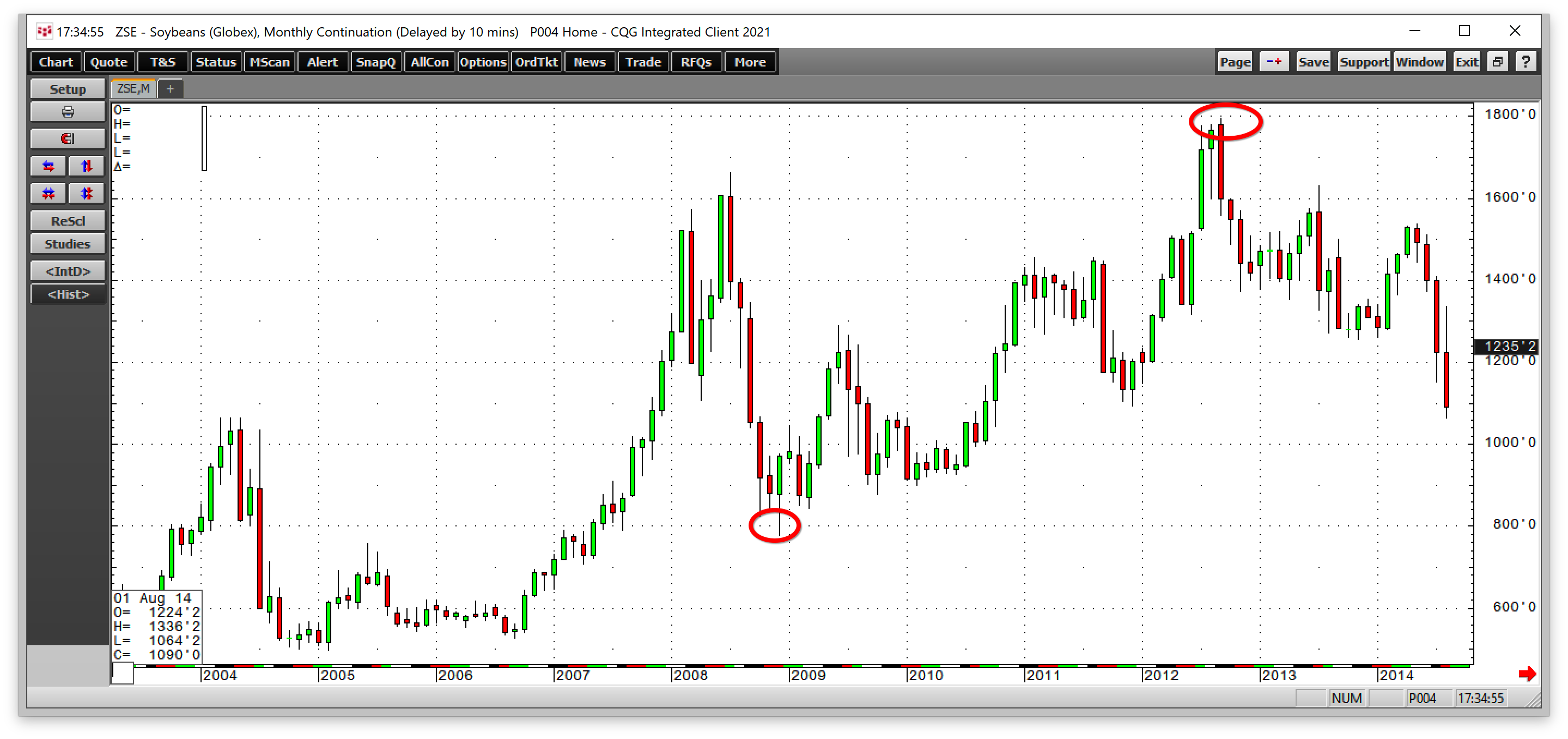
Source: CQG
The monthly chart of nearby soybean futures shows the rise from a low of $7.7625 in December 2008 to a record high of $17.9475 in September 2012.
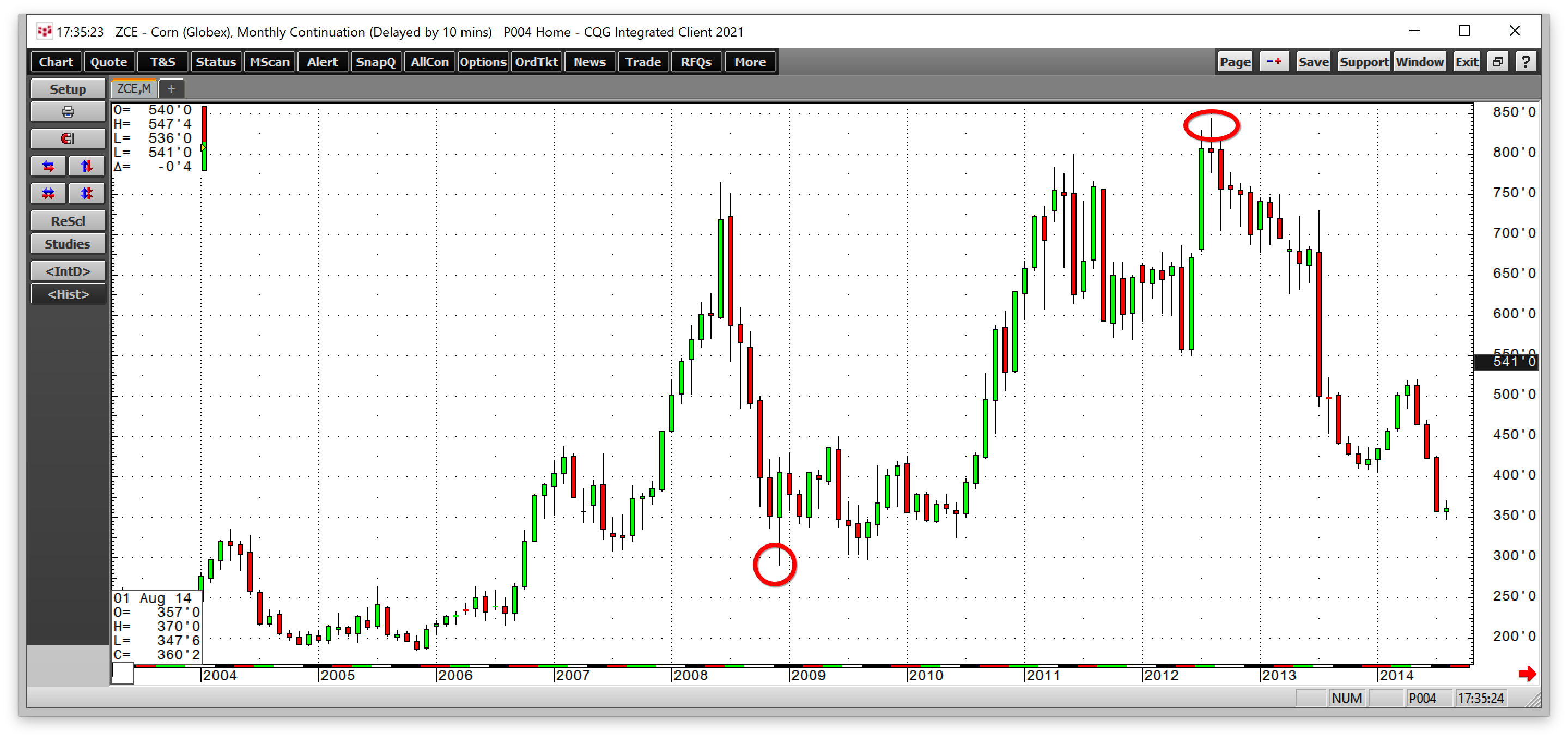
Source: CQG
Over the same period, nearby corn futures rallied from $2.90 per bushel in December 2008 to a high of $8.4375 in August 2012. While corn and soybeans reached record highs in 2012, wheat moved to the second-highest level in history after the price of soft red winter wheat futures traded to $13.3450 in early 2008.
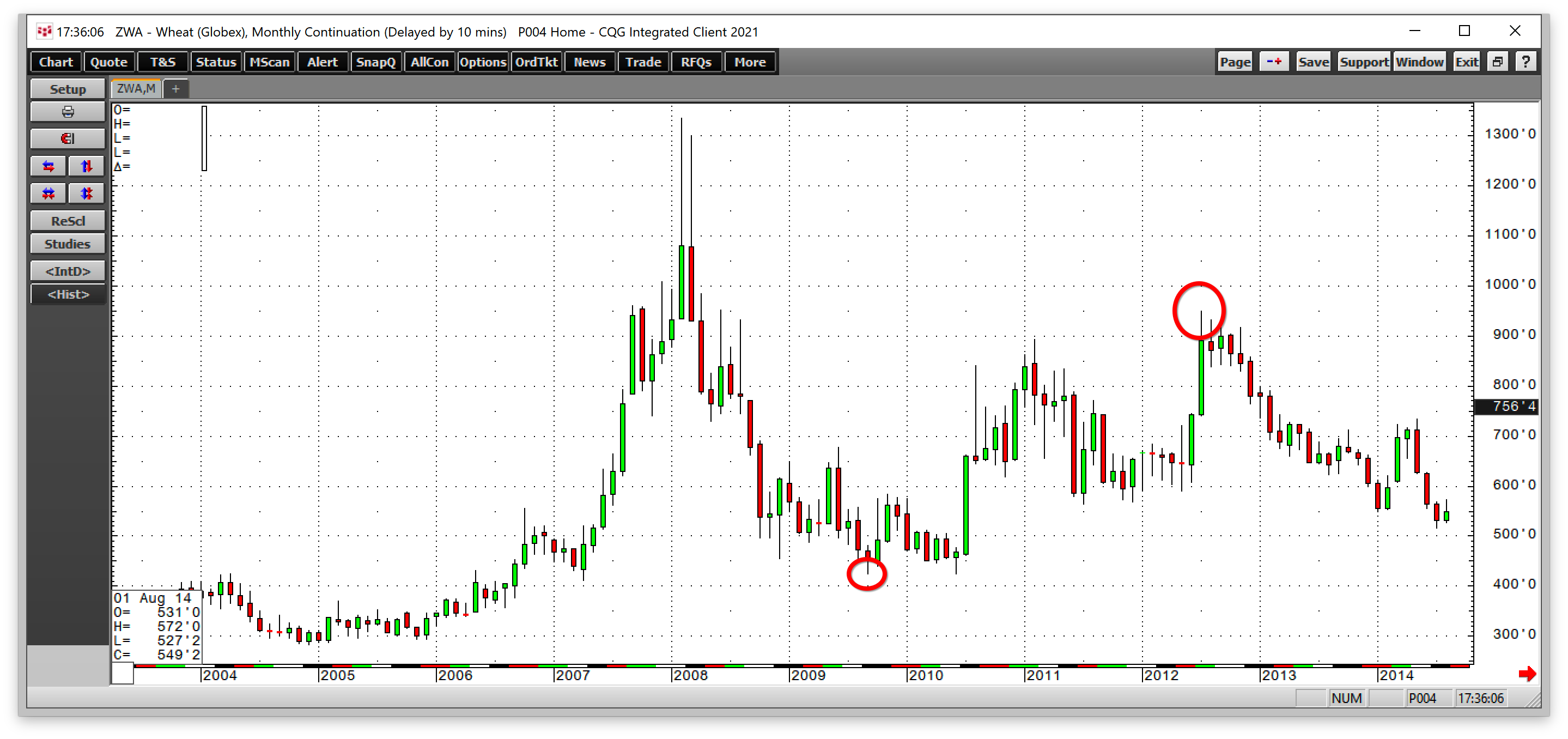
Source: CQG
CBOT wheat futures rallied from $4.2525 in September 2009 to a high of $9.4725 in July 2012. While dry weather conditions pushed the grain and oilseed prices to highs in 2012, inflationary pressures from the flood of liquidity and the lowest interest rates in modern times was another bullish factor for the commodities from 2008/2009 through 2012.
A model for 2021 and upcoming years for three reasons
Chapter two of low interest rates and quantitative easing began in 2020 as the global pandemic gripped the financial system worldwide. The only difference is the levels of the stimulus were far higher in 2020 than in 2008. We have already seen substantial appreciation in the three leading grain and oilseed markets after falling to lows in mid-2020.

Source: CQG
The weekly chart of nearby soybean futures shows the rise from $8.0825 in April 2020 to a high of $16.7725 per bushel in May 2021.
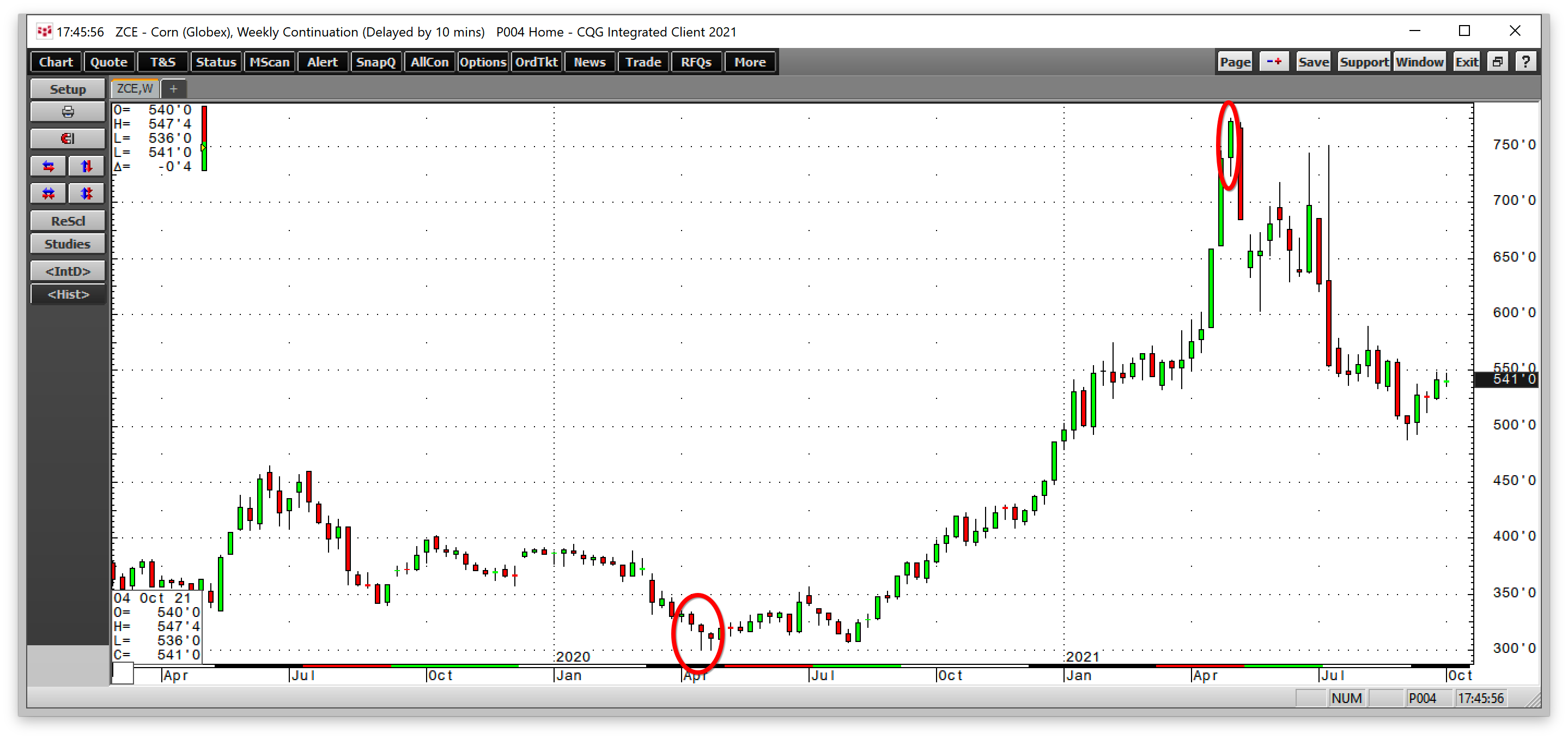
Source: CQG
Corn futures rose from $3.0025 in April 2020 to a high of $7.75 per bushel in May 2021.
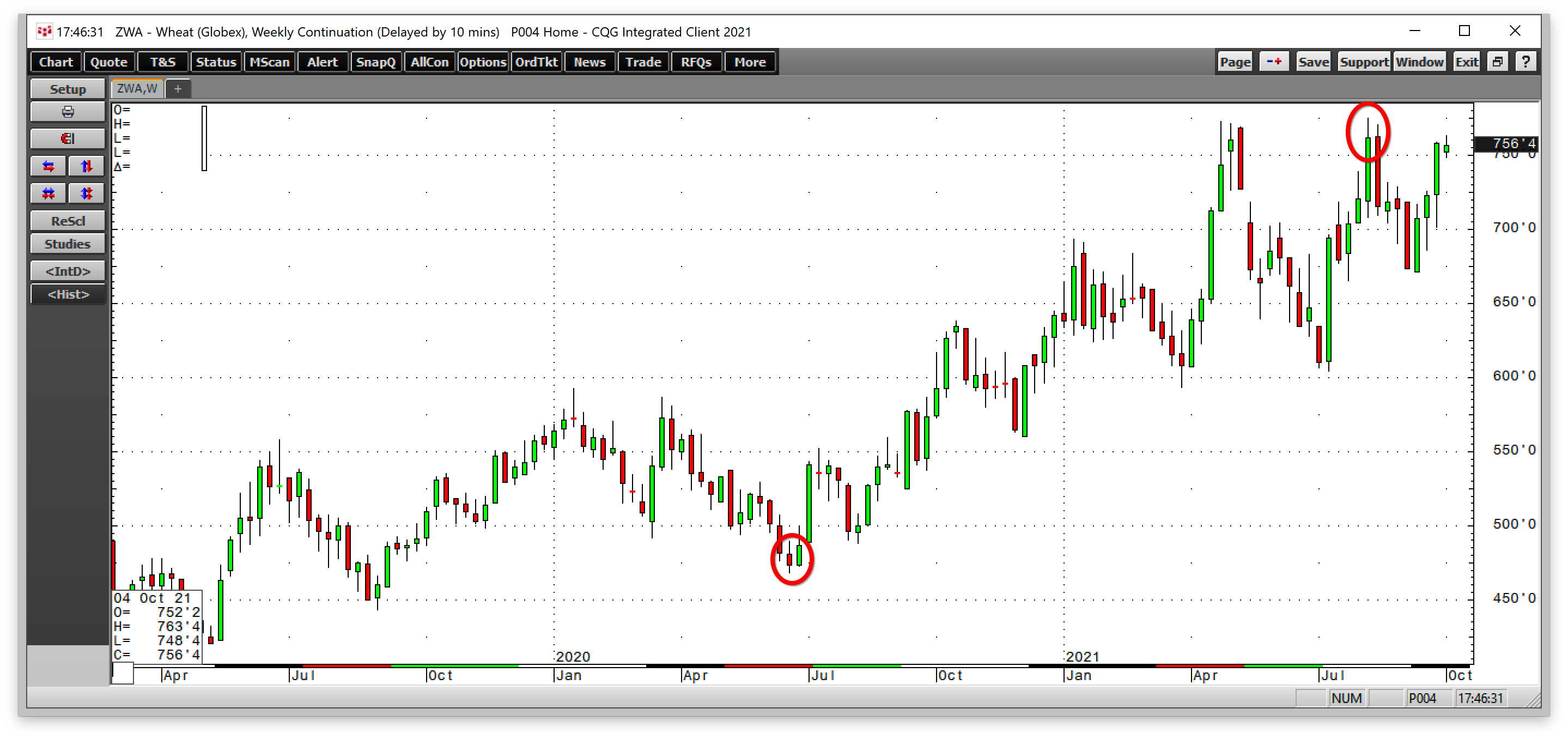
Source: CQG
Soft red winter wheat futures moved higher from $4.6825 per bushel in June 2020 to a high of $7.7475 per bushel in August 2021.
The third quarter of 2021 ended last week. Even though the prices have corrected from the 2021 highs, they remain appreciably higher than at the end of Q3 in 2020:
- Soybeans closed Q3 2020 at $10.2350 per bushel. At $12.5600 on Sept. 30, 2021, oilseed futures were 22.7% higher.
- Corn moved from $3.79 at the end of Q3 2020 to $5.3675 per bushel at the end of Q3 2021, or 41.6% higher.
- CBOT wheat futures moved from $5.7800 to $7.2550 per bushel on a year-on-year basis on Sept. 30, a rise of 25.5%.
However, there's a lot more going on in the agricultural commodities sector than the weather right now, pushing prices higher:
- Production costs are rising as farm equipment, energy, fertilizer, and other inputs have become a lot more expensive over the past year.
- Worldwide supply chain bottlenecks make it a lot more expensive to transport farm products from production to consumption sites. The Baltic Dry Index is an indicator for the cost of shipping dry bulk commodities. The BDI moved from the 1,636 level at the end of Q3 2020 to 4,962 at the end of Q3 2021.
- Even though the global pandemic has taken over 4.8 million lives, the worldwide population has grown by over 80 million over the past year, pushing the demand side of agricultural product’s fundamental equation higher.
Grain and oilseeds could be pressured lower in coming months
The US dollar is the world’s reserve currency and benchmark for pricing commodities. The Dollar Index measures the US currency against other world reserve currencies, with an over 57% exposure to the euro.
A stronger dollar tends to weigh on raw material prices, while a weak USD historically supported higher prices. The Dollar Index moved from the 93.927 level at the end of Q3 2020 to 94.24 at the end of September 2021, a rise of only 0.33%. The trend in the Dollar Index remains higher as we move into Q4 as it reached a new medium-term high in September. A continuation of strength in the US dollar could weigh on agricultural prices, but the price appreciation over the past year has been impressive, given the stable to higher US dollar.
Meanwhile, grain and oilseed prices are not the only agricultural commodities showing strength over the past weeks, months, and years. Coffee, sugar, orange juice, and cotton prices have risen to multi-year highs. Last week, cotton futures rose above $1 per pound for the first time in a decade, and coffee was above $2 per pound, a level not seen since 2014 before this year. Moreover, the greener path towards energy production and consumption is increasing the demand for corn, sugar, and other agricultural products that are critical ingredients in biofuel.
While the harvest season in the US and northern hemisphere could cause prices to ease over the coming weeks and months, the pandemic continues to grip the southern hemisphere, fueling labor and logistical issues for farming and transporting products to the global markets.
I believe that the period from 2008-2012 is a model for 2021 and the coming years. While the central banks may begin to tighten credit to respond to rising inflationary pressures, the tidal wave of liquidity and the ongoing tsunami of fiscal stimulus will continue to put upward pressure on prices even as supply chain challenges endure.
The bottom line: agricultural commodity prices are likely to continue their upward bias, which is bullish for the leading companies that feed the world and are on the cutting edge of the growing biofuel business.
Archer Daniels Midland: leading agricultural company worldwide
Archer Daniel Midland procures, transports, stores, processes, and merchandises agricultural commodities, products, and ingredients in the US and around the world. ADM’s website outlines the company’s products that provide nutrition and fuel that powers people’s daily lives. The Chicago-based company has positioned itself as “supermarket to the world.”
ADM’s earnings have beaten consensus estimates over the past four consecutive quarters.
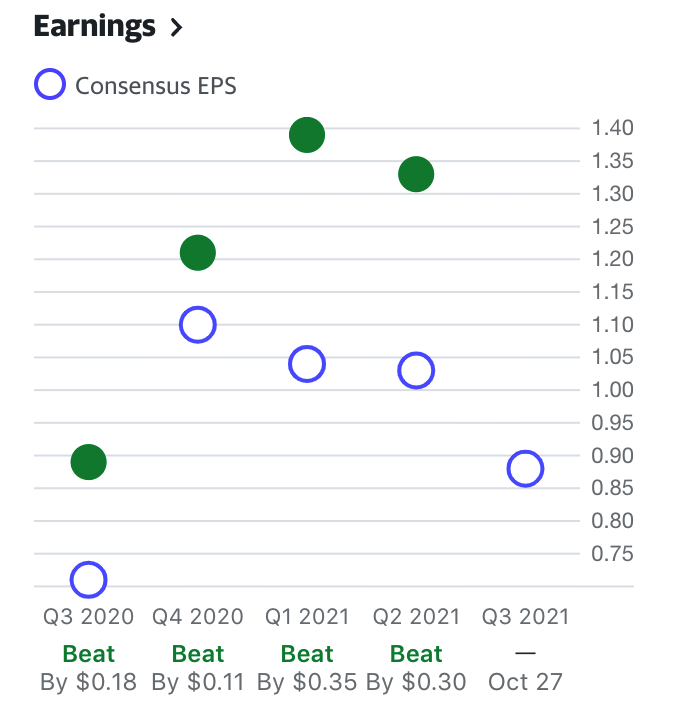
Source: Yahoo (NASDAQ:AABA) Finance
ADM will report Q3 earnings on Oct. 27. All signs point to another bumper crop of profit, beating the consensus forecast of 88 cents per share. A survey of 15 analysts on Investing.com projects an average share price of $67.54 for ADM, with projections ranging from $55 to $76.
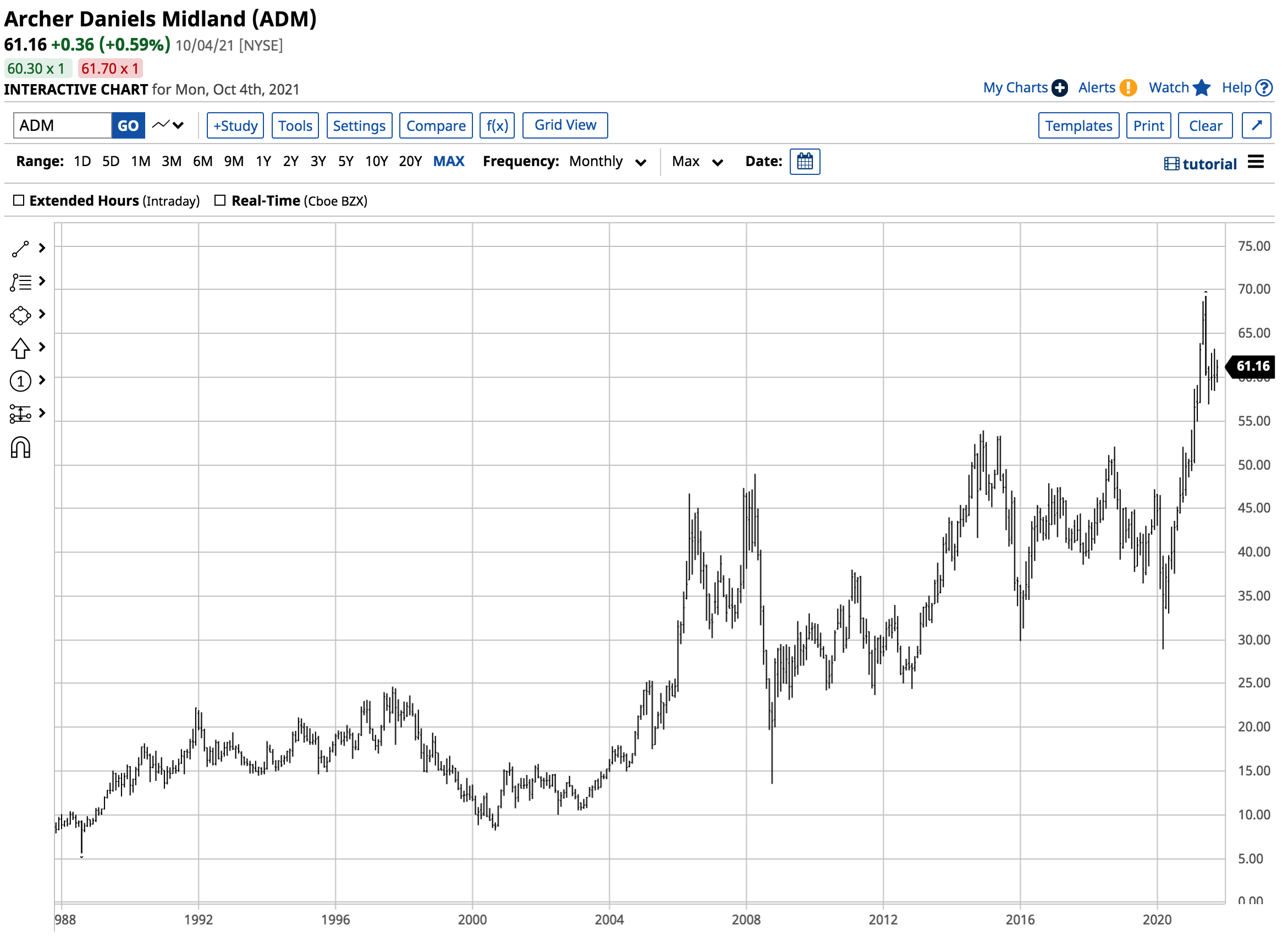
Source: Barchart
The chart above highlights the bullish trend in ADM over the past two decades, albeit with more than a few speed bumps along the way. Since the March 2020 lows, ADM rallied from $29.92 to $69.30 per share, with an all-time high in June 2021. At $61.16 per share on Oct. 4, the prospects for ADM shares remain bullish.
As well, the company pays shareholders a $1.48 annual dividend, translating to a 2.42% yield.
Bunge: another leader with exposure to Brazil
Bunge Limited is another leading agribusiness and food business worldwide. BG has significant exposure in Brazil, a leading agricultural commodity-producing country. BG also produces fertilizers and biofuels. The company’s website highlights BG’s many business lines.
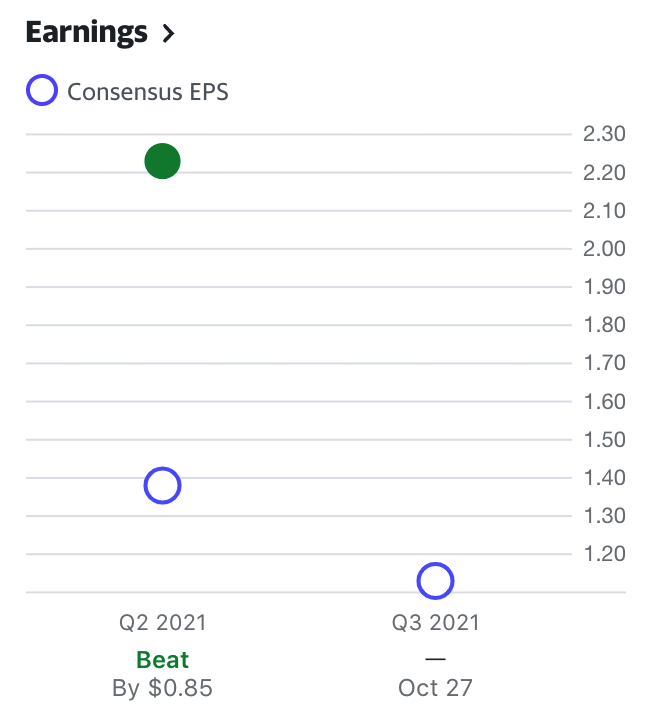
Source: Yahoo Finance
In Q2, the average forecast was for BG to earn $1.38 per share. The company reported $2.23, blowing away the estimates by 85 cents per share. The market expects BG to earn $1.13 per share when it reports Q3 earnings on Oct. 27. BG pays shareholders a $2.10 annual dividend, which comes out to a 2.54% yield at $82.59 per share on Oct. 4.
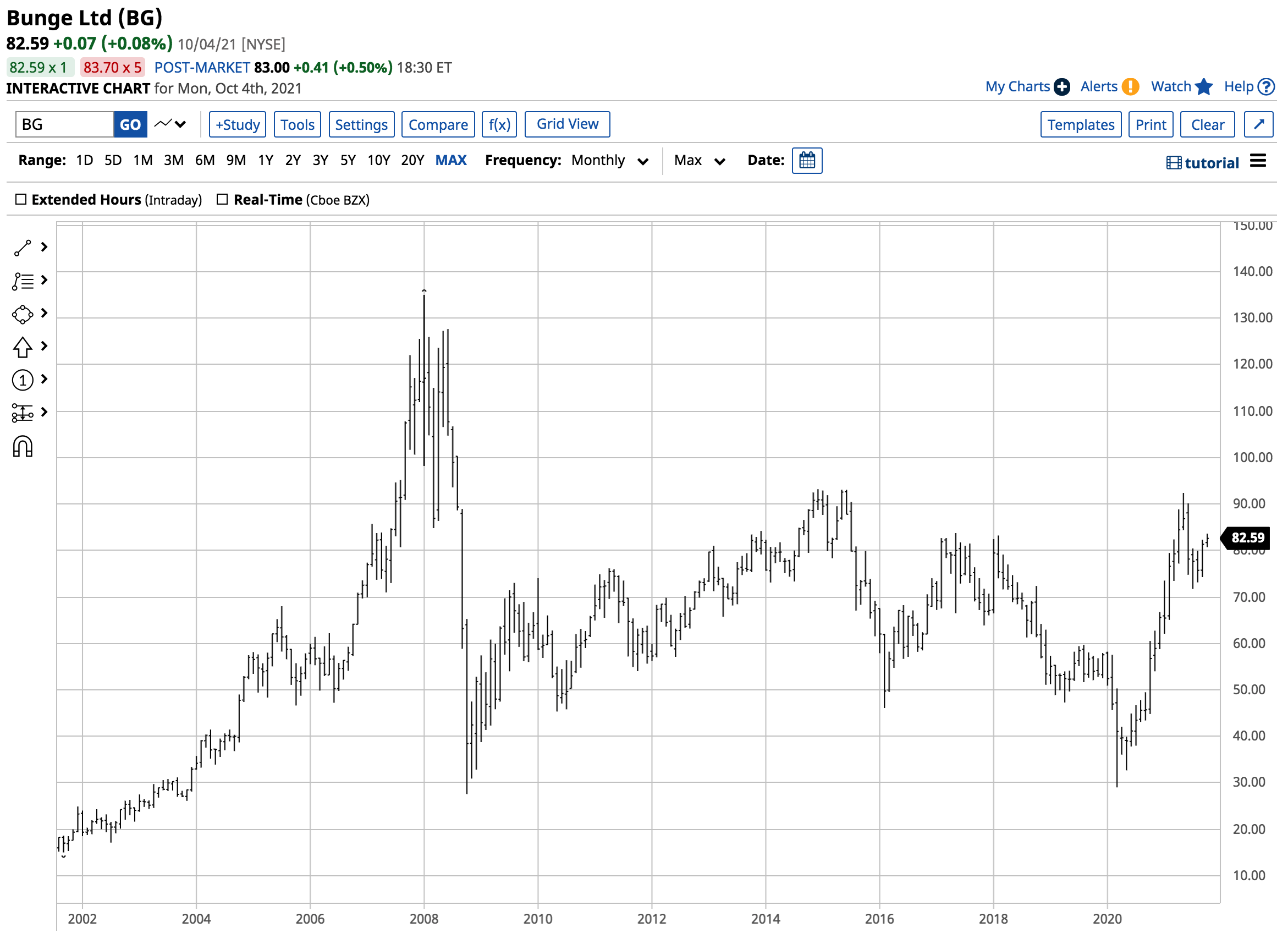
Source: Barchart
The long-term chart shows BG reached an all-time high at $135 per share in 2008. Since the March 2020 low, the shares appreciated from $29.00 to $82.59 as of Oct. 4.
BG has a market cap of just under $11.7 billion, while ADM’s valuation is at the $34 billion level.
I would be a buyer of ADM and BG on any price weakness over the coming weeks and months. If 2008-2012 is a model for the agricultural sector in 2020/2021 and the coming years, we could see a continuation of higher prices, lifting profit margins for the leading companies in this sector.
